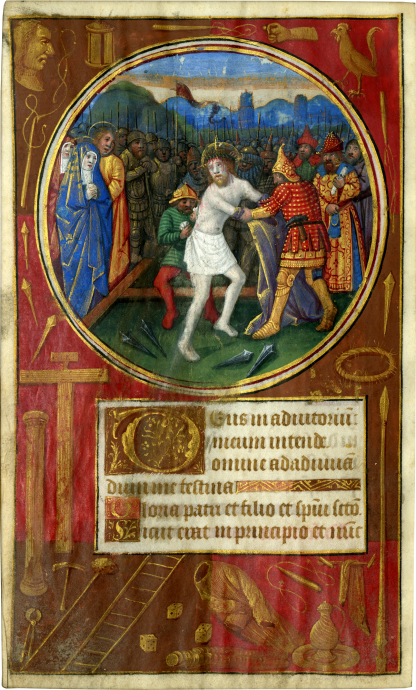


Follower of Jean Bourdichon and Jean Poyer
, c. 1490-1500
Follower of Jean Bourdichon and Jean Poyer
Description
This miniature of the Disrobing of Christ was painted by an illuminator active in Tours working in the style of Jean Bourdichon (1459-1521) and Jean Poyer (active 1465-1503), two of the most acclaimed painters of fifteenth-century France. It is one of five known miniatures illustrating the long Hours of the Holy Spirit from what was once a lavish Book of Hours. Each miniature depicts a scene from the Passion of Christ set within a roundel surrounded by finely painted borders in camaïeu d'or. The Disrobing of Christ illustrates the incipit for the hour of Sext from this evocative devotional sequence.
Christ is shown moments before the Crucifixion being stripped before a crowd of soldiers and pharisees while Saint John the Evangelist and the Virgin Mary helplessly look on. Christ's beaten, bloodied face stares upward toward heaven while four nails rest menacingly at his feet. The painting is executed with a rich palette; fabrics rendered with exquisite reds, blues, and gold. Christ's body is painted in a gauzy white that contrasts sharply against the dark crowd of onlookers and the ominous clouds stretching across the horizon. The border is filled with the various Instruments of the Passion painted in gold on an alternating ground of red and burgundy.
The four sister leaves include: a Man of Sorrows (Private Collection); The Entombment (Christies, July 15, 2015, lot 15); Christ Before Pilot (Private Collection); and Christ Carrying the Cross (Binghamton University Art Museum 1964.97). Just like the Disrobing of Christ, each miniature is set within a roundel and framed with the instruments of the passion painted in camaïeu d'or.
The miniaturist was clearly a follower of the so-called School of Tours, best known from the works of Bourdichon and Poyer. The twilight setting echoes similar lighting effects from Bourdichon's remarkable Hours of Anne of Brittany (Paris, BnF, MS lat. 9474). The face of Christ, his mother, and disciples are also rendered with emotional energy and evoke the pathos typical of Bourdichon's figures. The camaïeu d'or recalls the Hours of King Henry VIII by Poyer (Morgan Library and Museum, MS H.8), whose borders are filled with scenes painted in luxurious gold (Hofmann 2004, 58-59; Hearne, Voelkle, and Wieck 2000). A similar page design can be observed in the Labarde Hours made for Jean Labarde of Tours, with miniatures framed by roundels and borders painted in camaïeu d'or over an alternating ground of red and burgundy (Jörn Günther, no. 53). Comparatively, however, the Disrobing of Christ is of higher quality and was clearly executed by a painter with more formal training, perhaps with Bourdichon or one of his followers.
Provenance
Private Swiss Collection
Sister leaves
Christ Carrying the Cross, Binghamton University Art Museum (1964.97).
Entombment of Christ, Private Collection (Christie's, July 15, 2015, lot 15).
Christ before Pilate, Private Collection.
Man of Sorrows, Private Collection.
Text
Recto: Gloria Patri et filio et spiritui sancto. Sicut erat in principio, et nunc, et semper: et in saeculum saeculorum. Amen. Alleluia…
Verso: Deus in adiutorium meum intende. Domine ad adiuvandum me festina. Gloria Patri, et Filio et Spiritui Sancto. Sicut erat in principio, et nunc…
Literature
Unpublished; for works on Bourdichon and Poyer see:
Avril, François and Nicole Reynaud. Les Manuscrits à peintures en France: 1440-1520, Paris, 1993, p. 293-305.
Hearne, K. Michelle, William M. Voelkle, and Roger S. Wieck. The Hours of Henry VIII: A Renaissance Masterpiece by Jean Poyet. New York, 2000.
Hofmann, Mara. Jean Poyer das Gesamtwerk, Turnhout, 2004
Kren, Thomas with Mark Evans (ed.). A Masterpiece Reconstructed: The Hours of Louis XII, Los Angeles and London, 2005.
MacGibbon, David. Jean Bourdichon: A Court Painter of the Fifteenth Century, Glasgow, 1933.
For comparison to the Labarde Hours see:
Parchment and Gold: 25 years of Dr. Jörn Günther Rare Books, Stalden, 2015, pp. 276-81, no. 53.